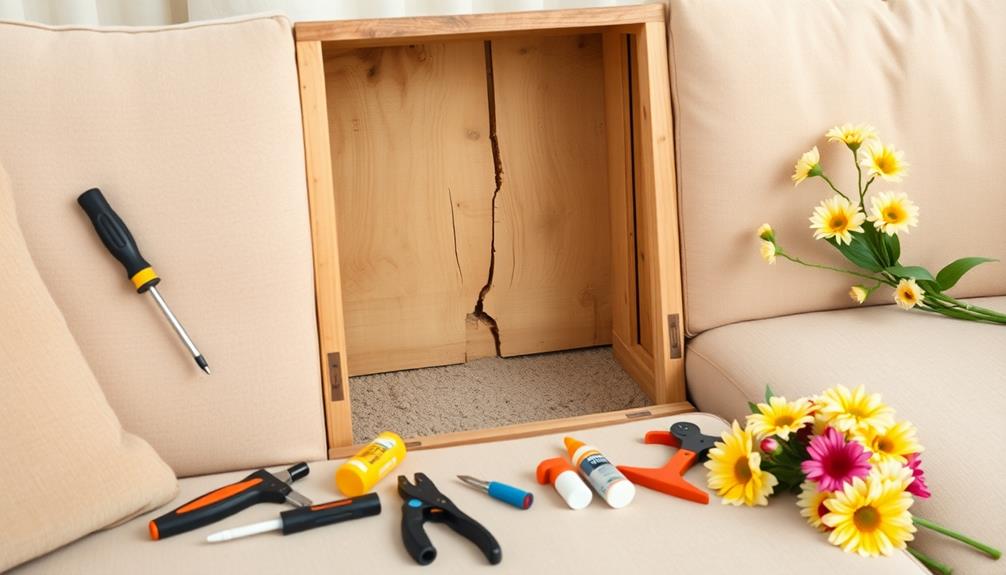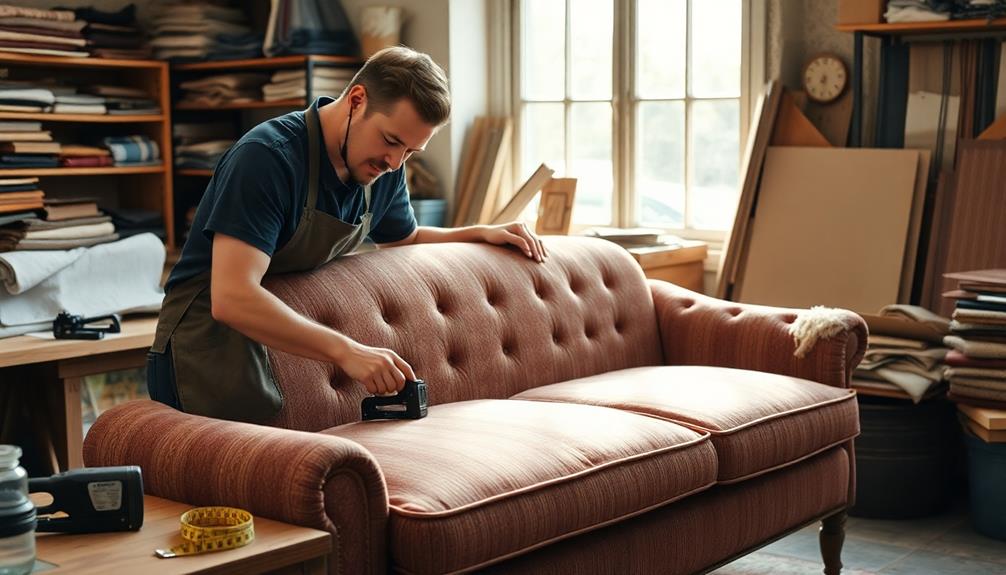In order to refresh your sofa, start by checking the springs for any sagging or damage. You will need necessary tools such as a spring pulling tool and pliers for any repairs. Carefully remove any faulty springs and replace them with new ones, ensuring they are properly aligned with the frame. Once in place, test the tension by sitting on that area. Make sure the frame is stable and inspect for any cracks or wobbling. Consistent upkeep, such as rotating the cushions, is essential for maintaining comfort. By using the correct methods, you can give your sofa a fresh lease on life, with numerous tips to assist you along the way. Additionally, examine the fabric or upholstery for signs of wear and tear, and if necessary, consider reupholstering for a new appearance. For sofas with a wicker or rattan base, repairing any broken wicker strands is crucial for preserving its structure and appearance. By diligently addressing both internal and external issues, you can ensure your sofa remains a sturdy and cozy focal point for years to come. Along with tending to springs and upholstery, it is crucial to pay attention to any wooden or wicker components. For wicker bases, following a **repair wicker furniture stepbystep** guide can simplify the process and ensure effectiveness. This guarantees that not only the upholstery, but also the structural elements of your sofa are well-maintained, keeping it functional and visually appealing for many years.
Key Takeaways
- Inspect springs for sagging or breaks to determine necessary repairs and improve seating comfort.
- Use essential tools like pliers, a staple gun, and a measuring tape for efficient spring replacement.
- Follow a step-by-step process to detach damaged springs and securely attach new ones for lasting results.
- Regularly rotate cushions and check spring tension to maintain overall sofa comfort and prevent future issues.
- Consider consulting a professional for complex repairs to ensure high-quality results and a lasting solution.
Assessing Sofa Damage

When you start evaluating your sofa for damage, it's crucial to look for specific signs that indicate wear and tear.
Check the springs first; if they're sagging or broken, you'll notice uneven seating and a lack of support. Listen for any creaking or popping sounds when you sit down—these are clear indicators of trouble.
Next, inspect the overall frame for stability; any cracks or wobbling can lead to further issues down the line. Regularly rotating your cushions can also prevent unnecessary damage.
If you spot multiple broken springs or complex issues, it might be time to consult a professional. Identifying these problems early helps you determine the best repair solutions and prolongs your sofa's lifespan.
Essential Repair Tools

Having the right tools on hand makes all the difference when it comes to sofa repair.
You'll need a spring pulling tool to safely remove damaged springs without harming the upholstery. Replacement springs, properly measured for fit, are vital to restore support. Pliers will help you manipulate and securely attach the new springs, while a staple gun is essential for reattaching the fabric afterward.
Don't forget to gather a measuring tape to guarantee accurate dimensions for replacements. Additionally, having a screwdriver set and wood glue on standby can be beneficial for any frame repairs you might encounter.
With these tools, you'll be well-prepared to tackle your sofa's spring repairs effectively and efficiently.
Step-by-Step Spring Repair

Sometimes, repairing the springs in your sofa can feel challenging, but with a clear step-by-step approach, you can tackle it with confidence.
First, use a spring pulling tool to detach the damaged spring carefully. Make sure you don't damage the upholstery while doing this.
Next, align the new spring with the sofa frame and attach it to the clips or brackets, making sure it's centered. Tighten any bolts or screws to secure the spring firmly in place.
Once attached, test the spring tension by sitting on the repaired area for support.
Ensuring Comfort Post-Repair

Ensuring your sofa remains comfortable after a spring repair is essential for maintaining its usability.
Start by measuring the upholstery thickness and evaluating the cushion foam density. This helps you determine if additional padding is needed for ideal comfort.
Sit on the repaired section to test the spring tension and make sure it offers adequate support. Adjust the sofa configuration if necessary, so everyone enjoys the best seating experience.
Regularly check the cushions and springs to prevent future issues. If you notice sagging or discomfort, consider rotating the cushions to promote even wear.
Keeping up with maintenance won't only enhance comfort but also extend the life of your revitalized sofa.
Alternative Repair Techniques

When your sofa springs show signs of wear, alternative repair techniques can offer effective solutions without a complete overhaul. You might consider using pliers or a spring stretcher to mend minor issues yourself.
For example, if a spring is slightly stretched or misaligned, gently adjusting it can restore support. Additionally, you can reinforce sagging springs by adding a layer of plywood or a sturdy board underneath the cushions, providing immediate support.
If you're comfortable, replacing springs is another option; just verify they're properly measured for a snug fit. Remember, patience is key during these repairs.
Regular maintenance checks can help you catch issues early, making sure your sofa remains comfortable for years to come.
Frame Damage Assessment

In evaluating frame damage, start by closely examining the structure for any signs of weakness or instability.
Look for cracks, splits, or warping in the wood, as these can compromise the sofa's integrity.
Pay attention to joints and connections; if they feel loose or wobbly, it's a sign that repairs are needed.
Check for broken or missing screws and dowels, as these are critical for maintaining a sturdy frame.
If you notice significant damage, it may require more extensive work.
Minor issues can often be fixed with wood glue or screws, but for severe damage, you might need to replace parts of the frame.
Evaluating these factors early can save you time and effort in the long run.
Professional Repair Considerations

After evaluating the frame damage, you might reflect on whether to tackle the repairs yourself or hire a professional.
While DIY repairs can save money, complex issues often require expert attention. Here are some points to reflect on:
- Experience: Professionals have the skills to identify and fix intricate problems.
- Tools: They possess specialized tools that aren't always available to the average homeowner.
- Time: A professional can complete repairs more quickly, allowing you to enjoy your sofa sooner.
- Quality: Expect higher quality repairs with lasting results.
- Warranty: Many professionals offer warranties on their work, providing peace of mind.
Ultimately, weighing these factors will help you decide the best route for your sofa repairs.
Frequently Asked Questions
How Often Should I Check My Sofa Springs for Damage?
You should check your sofa springs for damage at least twice a year. Look for sagging or creaking sounds. Regular inspections help maintain comfort and prevent costly repairs, ensuring your sofa lasts longer.
Can I Replace Springs Without Removing the Sofa Fabric?
You can't effectively replace springs without removing the sofa fabric. Doing so allows you to access the springs safely and guarantees proper installation. It's best to remove the fabric for a thorough repair.
What Type of Springs Are Best for My Sofa?
When it comes to springs, you want to hit the nail on the head. For comfort and durability, consider high-quality sinuous springs or eight-way hand-tied options. They provide excellent support and longevity for your sofa.
How Can I Prevent Future Spring Damage?
To prevent future spring damage, regularly rotate cushions, avoid excessive weight, and inspect springs for wear. Keeping your sofa clean and maintaining proper support guarantees longevity and comfort, maximizing your investment in quality furniture.
Is DIY Spring Repair Cost-Effective Compared to Professional Help?
While tackling spring repairs yourself can seem like a penny-pinching adventure, it often leads to unexpected expenses. If you're unsure, it might be wiser to invest in professional help for guaranteed comfort and longevity.
Conclusion
Now that you've mastered the art of spring repairs, picture yourself sinking into your revitalized sofa, the supple cushions cradling you like a warm embrace. The once sagging springs now offer firm support, inviting you to relax and unwind. With your hands having restored comfort to your favorite spot, you can enjoy countless cozy evenings with loved ones, laughter echoing off the walls. Your sofa's new lease on life transforms your living space into the haven you've always dreamed of.









